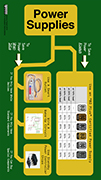greener materials
Overview
 Goal: Understanding what makes materials more or less sustainable, and comparing common materials.
Goal: Understanding what makes materials more or less sustainable, and comparing common materials.
You have an amazing variety of materials to choose from — more than any inventors or designers of the past ever had. But the sheer multitude of considerations for choosing sustainable materials can be dizzying. There’s no such thing as a green material by itself; it’s about matching the material to the job. That means considering the environmental impacts of the material, its function, and the whole system it fits into.
An ideal sustainable material:
- is abundant / rapidly renewable
- is resource-cheap (requires minimal energy or other material to produce)
- is chemically safe and healthy
- has many lives (via recycling, reuse, or composting)
- is socially benevolent
- is financially affordable
- meets relevant laws and labels
- functions well (doesn’t break or wear prematurely, etc.)
- greens the whole system, not just itself
Below are three short videos giving more detail about approaches to selecting greener materials, environmental considerations for materials, and selecting materials with the right physical properties:
Autodesk Sustainability Workshop Introduction to Green Materials Selection
Autodesk Sustainability Workshop Environmental Properties of Materials
Autodesk Sustainability Workshop Physical Properties of Materials
Choosing Better Materials
Now that you know about some of the tradeoffs for materials selection, how do you know what options are available?
For quick reference, you can see charts created by Jeremy Faludi, published on Instructables. They can help you compare commonly-available metals, plastics, and woods; for electronics, a chart for choosing power supplies is also included:
Metals |
Wood |
Plastic |
 Power Supplies |
You can also look up tables of environmental impacts per kg of material calculated by life-cycle assessment (LCA). Two good sources are Okala Practitioner and Ecolizer. Simply look up different materials to compare them—lower scores show lower impacts per kg of material. These scores don’t measure everything (like social impacts, some kinds of toxicity, or material functionality), but they’re a good start.
For clothing and soft goods, it’s often hard to find LCA data. Try the Sustainable Apparel Coalition’s Materials Sustainability Index. Note that this system is incompatible with LCA scores, so it won’t help you compare fabrics to metals. However, it is a good start for understanding some sustainability tradeoffs.
Materials Safety Data Sheets (MSDS) can also be good sources for information on materials, listing major toxicity or physical hazards like flammability. These are available from material manufacturers, often on product websites.
Finding Materials and Swapping Materials
The two ways you’ll most likely improve your product’s materials are by finding new materials (at least new to you), and by thoroughly brainstorming how to swap out your current materials for better ones. Here are guides to both of those:
All VentureWell Tools for Design and Sustainability content is shareable and usable by CC BY-NC-SA 4.0 license.